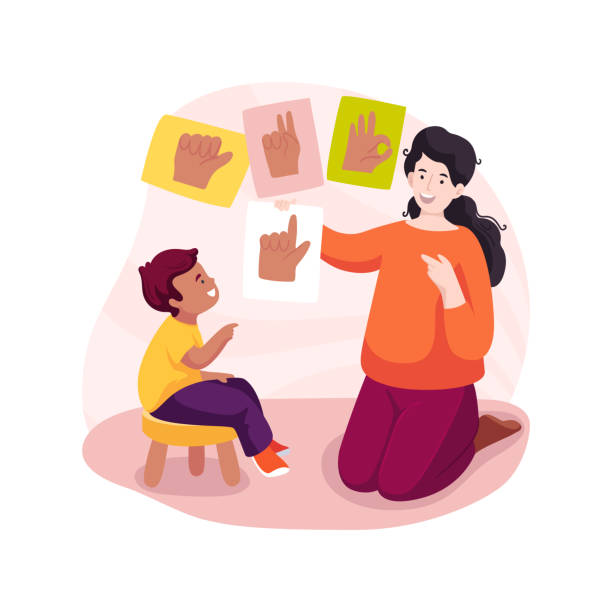What is the best way to communicate with my deaf child? Should we use sign language, spoken language with visual aids, or a combination?
Many different communication Methods may benefit your child. There is no “right”, or “perfect” answer for everyone. Many factors go into what would be the best for your child. The best method for you and your family will vary. Here is a summary of what your options may be, however, it is important to talk with your team to help figure out what is the best method for you. To help better understand them we have broken them down into separate categories. With this being said we ask that you keep in mind that with new research coming up, what seems to be the most important is that your child is given access to a full language as quickly as possible to keep development and mile markers normal. With this being said we strongly suggest the route of learning ASL or giving a total communication approach.
Oral Methods
These methods focus on the production and reception of spoken language without the support of visual-manual language or the assistance of an artificially developed communication system.

- Auditory/Verbal:
- This therapy has an approach that relies on the application and management of technology along with strategies, procedures, and techniques that focus on teaching children who are deaf and hard of hearing how they can communicate through speech. Early in the therapy sessions emphasis is stressed on listening while restricting the child’s access to lipreading. This therapy stressed the importance of early identification, the consistent use of binaural amplification, strong parental involvement, and integration of family, academic, and social activities. It teaches parents how to provide beneficial listening environments that promote listening and auditory learning, they become instrumental in the therapeutic process. These therapies are based on the belief that as children begin to understand the value of sound they will later intuitively understand the function hearing serves as they develop. The ultimate goal is to provide children with strategies and techniques so they can utilize their residual hearing to the fullest extent possible.
- Auditory/Oral:
- These approaches emphasize strategies that simultaneously promote the use of residual hearing and techniques that foster lipreading. Children are then encouraged to develop their spoken language skills by using both auditory and visual cues. These therapies recognize that students may benefit from a resource room or partial mainstreaming. These therapies also may focus on the techniques being delivered through a structured fashion or by using a more natural approach.
- Natural Oralism:
- Emphasis is placed on the use of residual hearing while facilitating natural language development. Parents are instructed to talk with their child using age-appropriate language, however not encouraging their child to imitate or respond to their comments. This method emphasizes early identification and the use of technology. Something that separates this approach is that children are encouraged to be active participants in the communication process without being corrected on their speech production.
- Maternal Reflexive:
- Focuses on attention given to exposing the text from the very beginning stages as well as the reflection. Students are asked to write down the conversation and then analyze it while paying particular attention to grammar, register, style, and form presented in the document.
Visual Methods
These methods focus on the visual modes of communication

- ASL(American Sign Language):
- ASL is a visual-gestural language, a rule-governed language that was created by and for deaf individuals living in the United States. It is known for being able to provide a systematic means for communicating thoughts, ideas, and feelings through the use of conventional symbols. ASl uses the visual representation of concepts utilizing three-dimensional space to transmit information.
- SE(Signed English):
- Signed English is an English-based sign system designed to be used simultaneously with speech. The system has two types of visual representations being used: approximately 3,000 sign words and 14 sign markers. Each sign word represents a separate entry in the standard English dictionary.
- SEE I (Seeing Essential English):
- This is a concept, not a method, and is based on the linguistic structure of English. The sign system contains about 5,000 signs with each each sign only representing one English word. Each sign was designated as a root sign with affixes, syllables, and free-bound morphemes are referred to as part signs. People using SEE 1 can express English word order using English signs.
- SEE II (Signing Exact English):
- This is currently the most widely used signing system. Tends to parallel English morphology. The SEE II manual consists of 2,100 signs, 70 affixes, and 7 contractions. This method has been incorporated into several school systems and the goal is to provide students with a visually clear English model whereby they can master the English language and succeed academically.
- CASE (Conceptually Accurate Signed English):
- This system is based on the meaning of the idea being conveyed rather than the English word that is being used. When using this signing method signs are performed in English sentence structure while simultaneously mouthing
- CS or PSE ( Contact Signing or Pidgin Signed English):
- Typically combines certain vocabulary items and grammatical structures from the native languages of each group. Often becomes the middle ground for Deaf native signers who use ASL and individuals who know ASL but are not fluent in it.
Multimodal Methods
The Multimodal approach combines both spoken language and visual communication. In some instances, equal focus is placed on speech and sign. At other times signs are only used to utilize and support speech.

- Cued Speech:
- This is a communication approach used to assist in the development of spoken languages. This approach places equal stress on audition and vision. In this, method one hand is used to supplement information on the lips
- SSS (Sign Supported Speech):
- This method is for when the family’s primary concern is for the child to develop speech. This method uses signs and the signs are used to develop speech and language until they are no longer needed. The signs are used as a bridge to connect words that are not easily seen or heard, once the child can utilize the auditory information and produce the words correctly the signs are then eliminated.
- TC(Total Communication):
- This is a philosophy containing the incorporation of aural, manual, and oral modes of communication to ensure effective communication with and among hearing-impaired people.
- SC (Simultaneous Communication):
- involves signing and speaking at the same time When individuals use this method they are choosing one of the manually coded sign systems while talking and the goal is to provide a visual form of English. It should be noted that when attempting to maintain speed or choosing a topic with highly technical terms people tend to drop signs making sometimes the overall message unclear.
- Bilingual:
- This refers to when a person has fluency in 2 languages. In these situations, it would be the child becoming or having mastered fluency in both ASL and English because the other signing communication styles are not considered languages.